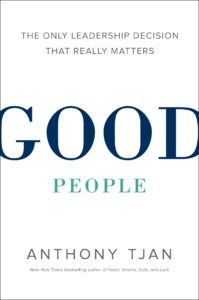People Matter
Leaders will always say that the most important part of their company is their people. People-first philosophies abound. Don’t believe it? Look at the plaque on the wall extolling the value of people.
But often the saying on the wall is not reality on the floor. It’s far too common to see people judged strictly on today’s achievements and not by their integrity and compassion for others.
Anthony Tjan’s new book, Good People: The Only Leadership Decision That Really Matters, is about defining goodness as a skill that can be learned and mastered, about the culture that’s created when we focus on people in a completely different way. I recently spoke to him about his philosophy. Anthony is an entrepreneur, strategic advisor, and venture investor.
Understand True Goodness
The “Good People Mantra” is a powerful and simple summation of your philosophy. Would you share it with us?
Of course. The Good People Mantra is about five principles and commitments that define what true goodness really means. Think of this as a sort of Hippocratic Oath for leaders to follow. It begins with always being people-first. Make your decisions with this filter in terms of how will the outcome affect my people? Second, recognize that goodness is really defined in terms of how you can make others feel and become the fullest version of who they are. When you are in their presence do you do that? Or when you are in the presence of someone else do you feel that? Third, goodness is something much bigger than competency – it requires character and values. Fourth, goodness requires one to be balanced against the tensions and realities that fight against it. We need to be self-aware of these tensions and ask the right questions to make us better at finding balance. Fifth, do goodness not only when you are morally tested or trying to avoid being bad but, rather, do goodness whenever you are in a position to do so. Real goodness comes from those who practice being good whenever the situation allows. And recognizing that this is a life-long pursuit and intention.
How did the Goodness Pyramid get developed?
The Goodness Pyramid was an attempt to put language to what we mean by goodness. The word “goodness” is one of those over-used but under-defined word. The Goodness Pyramid is a framework that is partially inspired by Maslow’s Hierarchy of needs and came after much self-reflection that was coupled together with a deep dive into secondary research and nearly 100 interviews with some of the most respected leaders. The people we sought to interview were people regarded not just for their great competency but equally for their great character. Ultimately the effort resulted in putting a language around three cornerstone qualities that make up goodness – truth, compassion and wholeness. At the foundation of the pyramid is truth as everything must begin with a mindset of humility, the practice of self-awareness, and actions of integrity. From truth, the middle layer of the framework’s pyramid is about compassion. This is where goodness is felt through one’s openness, empathy and generosity. Ultimately at the top of the pyramid is wholeness, which is a never-ending quest for which to strive. The concept of wholeness is about having a level of self-satisfaction with where you are because you are confident that you have made best and smart efforts to get there – always informed by love, respect and wisdom.
Cultivate Compassion
Compassion seems to be getting more lines in business books these days. I’d love to know more about your view. Is it possible to cultivate compassion?
It absolutely is possible to cultivate compassion, and furthermore it is important to note that compassion is not incompatible with being competitive and hard-charging towards value creation. This is part of what made the great UCLA coach John Wooden so respected – he understood the difference between winning and success. I doubt anyone who knew Wooden would call him undisciplined and soft, but that is the problem we have with who people think of compassionate leadership. Much about compassionate leadership is about shifting the mindset to helping others succeed to the best that they are able. As Ken Blanchard and one of his prodigies Garry Ridge (current CEO of WD-40) have written, “Don’t mark my paper. Help me get an ‘A’.” It is less important to be right about a situation than to help someone else understand why you might be right or help them get to the place they need to be and to do so with respect and kindness. You can cultivate this through the values we put forth in the Goodness Pyramid – by starting with a mindset of openness. One of the tools I suggest here is a 24×3 rule of optimism. The next time you hear an idea do this: WAIT at least 24 seconds before responding to it, and after 24 seconds consider seeing if you can for 24 minutes, or better 24 hours think of every reason the idea might work before criticizing the reasons for why it won’t work. Having a mindset of openness and practicing empathy and doing small acts of kindness such as bringing coffee to an employee – even though you might be the boss – are all things that that can help further one’s compassion.
Cultivate Your Values
Wholeness. You define it in part with gratitude and respect. I think of the United Airlines PR debacle and the lack of respect demonstrated. How do you teach and cultivate these behaviors throughout an organization?
These values of having a nurturing culture, a respectful one and one of gratitude, need to be expressed longitudinally over time. You can cultivate these with one simple rule: leaders should be in the business of producing other leaders. If you live by that, then you hope that people can make the right decision in moments like United, and even if they don’t, that they will respond afterwards with the right accountability and empathy towards their actions. Leadership ultimately begins at the top, but it has to practiced, lived, and distributed throughout the organization.
You are obviously a fan of John Wooden and his thinking. What are a few lessons you gleaned from him?
His definition of success is perfect: “Success is peace of mind, which is a direct result of self-satisfaction in knowing you made the effort to do your best to become the best that you are capable of becoming.” It is effectively our definition for wholeness at the top of the Goodness Pyramid.
Wooden also just was a class act in the way he practiced respect and telling his players that one of his absolute rules was to never criticize another teammate. It is a reminder to me that when you are looking for talent that goes beyond competency and has deep character, you want to avoid those people who are quick to judge others – often these are people who may use “warning words” of: “you always, you never or you should…”
5 Tensions to Balance
You share 5 tensions that we must balance. Would you share one and how it plays out?
 We have different tensions and biases that we must balance in leadership and life decisions. One of the most significant of these is the trade-off between short-term and long-term choices. Most of us experience “present bias.” That is we tend to overweight the short-term and underweight the long-term. There tends to be a discord between what we want in our future self with our present self because we always believe we can change later or that small “bad” behaviors can be changed later. It is why smoking, diets, or lack of regular savings are challenging for so many people – you know your lack of discipline will hurt you in the long-run but you don’t, for example, do the simple practice of saving say even $5-10 per day early in your career which would guarantee secure retirement. In business, the tradeoff and bias is the same. You may believe and know the right thing to do for the long-term but feel pressures for short-term performance. Think about any public-company, and I think the point is clear. The key is to have discipline and conviction to play long-ball. This is at the heart of my own investment firm where we have decided to have an evergreen capital pool that has no short-term pressures for liquidity, and it is at the heart of how one of the greatest investors of all time thinks – Warren Buffet who looks at businesses that you would theoretically want to own forever.
We have different tensions and biases that we must balance in leadership and life decisions. One of the most significant of these is the trade-off between short-term and long-term choices. Most of us experience “present bias.” That is we tend to overweight the short-term and underweight the long-term. There tends to be a discord between what we want in our future self with our present self because we always believe we can change later or that small “bad” behaviors can be changed later. It is why smoking, diets, or lack of regular savings are challenging for so many people – you know your lack of discipline will hurt you in the long-run but you don’t, for example, do the simple practice of saving say even $5-10 per day early in your career which would guarantee secure retirement. In business, the tradeoff and bias is the same. You may believe and know the right thing to do for the long-term but feel pressures for short-term performance. Think about any public-company, and I think the point is clear. The key is to have discipline and conviction to play long-ball. This is at the heart of my own investment firm where we have decided to have an evergreen capital pool that has no short-term pressures for liquidity, and it is at the heart of how one of the greatest investors of all time thinks – Warren Buffet who looks at businesses that you would theoretically want to own forever.
How do leaders best cultivate a culture that practices people first?
Goes back to what I opened, with in the Good People Mantra. You simply have decisions filtered through the lens of, “Will my action help, be neutral or negative to the people around me?” That is to say that you prioritize people over ideas, technology or financial lens. That is not to say those other things are not important but that you never forget that your team and stakeholders must come first. If you start with your purpose and people, great product and profits tend to follow.
For more information, Good People: The Only Leadership Decision That Really Matters.

